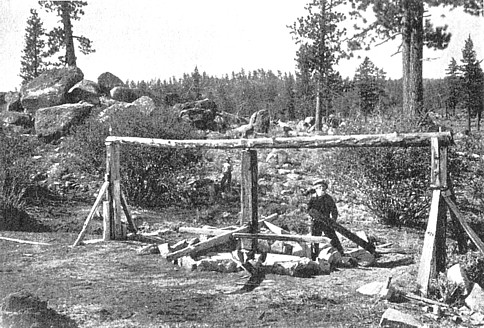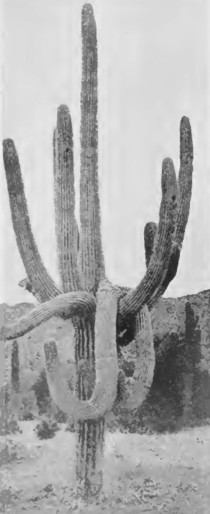GLOBE, GILA COUNTY
This is a large district, embracing what is sometimes called the
McMillen District, which, it is claimed, was irregularly formed, and the
Richmond Basin. It includes the Apache Mountains and the northeastern slope
of the Pinal Mountains. The Pioneer District bounds it on the west. This
section of the country affords fine facilities for mining. The forests of
pine and other timber furnish good lumber and wood for fuel, while Pinal
Creek and other small streams furnish ample water for milling purposes. The
ores are gold, silver, copper, and lead. Large, well-defined veins, with
prominent croppings, are found throughout the district, and mineral float
frequently covers the surface. The climate is mild and healthful. The
Richmond Basin is situated fourteen miles northeast of Globe, in a hollow
plateau of the highest part of the Apache range. The mountains immediately
back of it, forming the eastern barrier, rise boldly in Alpine peaks
hundreds of feet above the plateau. The prevailing rock in this section is
porphyry, which forms the walls of the mineral veins, and gives assurance of
their permanence. These solid rocks have been rent and torn asunder, and
washed away, leaving the
silver ore on the surface of the basin, where so many nuggets
of the
native silver metal have been found. In this basin are
located the Mack Morris, Richmond, East Richmond, Silver Nugget, and other
valuable properties.
The Stonewall Jackson, belonging to the McMillen Mining Co., is a noted silver mine located on the northeastern slope of the Apache Mountains. It was discovered by Harris and McMillen in 1875, from float ore and croppings, some of which were exceedingly rich. This mine has furnished some of the richest and most beautiful specimens of silver ore ever seen. Native silver is found sometimes in single wires, sometimes in spider web-like forms, and again in pieces which look like fern leaves. It contains no gold. Uninterrupted veins of pure wire silver, many feet in length, run through the pay streak. The following extract from the report of this company for 1877 will give an idea of the wonderful richness of some of this ore: "The main shaft was sunk directly on the vein of native silver metal to the depth of ninety feet, and showed a continuous vein of native silver from within ten feet of the surface to the bottom of the shaft, varying in width from two to six inches of solid metal. Intermingled through the metal is found yellow spar, the metal being closely encased in quartz from one to two inches in thickness, the quartz carrying more or less native silver and chloride of silver. In the bottom of the shaft the solid metal was four inches in width.
The following result of ore shipped to San Francisco is taken from the same report : 10,693 pounds of ore returned a total value of $64,361.71, or an average per ton of 2,000 pounds, of $12,138. The working shaft is over 400 feet in depth, surmounted by good steam hoisting machinery. The mine has been explored about 600 feet in depth. Good ore is said to be found in the deepest workings. A large amount of ore was taken from the mine before the incorporation of the present company; since the incorporation the production has been about $400,000. The company owns a good ten stamp mill, and besides has all the appliances necessary for working the mine. The office of the company is in San Francisco. J. K. Smith is Superintendent. The Mack Morris. The main shaft in this mine is now down 350 feet; it is surmounted by good steam hoisting works. Stopeing is going on in the 300 foot level. The ledge is eight feet in width, and said to be improving with depth. Ore has been taken from this mine hat would mill $4,000 per ton. The company owns a ten-stamp mill, which commenced running on the 1st of July, 1880, and up to the 1st of May, 1881, it had produced 100 bars of bullion of the total value of $175,944.78. The office of the company is in San Francisco. M. A. Baldwin is Superintendent.
The Alice. This is a silver ore mine which has been producing good ore for some time past. The mine is well opened, several levels have been run, in which stopeing is now going on, and it is reported that there is a large quantity of ore now in sight. The ore is being reduced in the Globe City mill. The Old Dominion. This company owns the Old Dominion, Keystone, New York, and Chicago copper mines. On the Old Dominion and Keystone there is now 185 feet of shaft and tunnel, all in ore. The tunnel has exposed a large body which can be extracted at little expense. On the New York and Chicago there are 230 feet of tunnel and cuts, showing an immense body of high-grade copper ore of green malachite and blue azurite carbonates, red cuprite oxides, and glance. The company has recently erected smelting works at Bloody Tanks, and will no doubt soon be shipping a large amount of copper. S. L. Burbridge is Superintendent. The Independence is a silver mine which has been well opened by shaft and levels. It is now yielding ten tons per day of good ore, some of it paying as high as $100 per ton. In addition to the above named the following mines in this district are now reducing ores and producing bullion : Silver Mines —Southwest extension of the Alice, Cox & Coplin, Stonewall No. 1, Emeline, La Plata, Centennial, and Democrat. gold ore Mines - Golden Eagle, Andy Campbell, Golden Nugget, Moffatt, Eureka, and the Munson and its extensions.
The following mines are now extracting rich ore, and some of them have heretofore produced bullion: Fannie J., Capital, Blue Bird, Silver Bow, Big Injun, Red Cloud, Turk, Libby, Rescue, Champion, East Richmond, West Richmond, Silver Nugget, Irene, Miama, Quinn, Sherman, Orion, Great Eastern, Big Johnny, Shambone, Centralia, Metamora, Chromo, Hannibal, and Washington. Copper Mines—True Blue, Cadmus, Carrie, Tacoma, and Illinois. There are many other mines in the district which are being prospected and yielding more or less good ore. Among these may be mentioned the Julia, Fitz John Porter, South La Plata, Silver Fame, Golden Chariot, Red Robin, Chloride, Trojan, and Silver Joe.
GOLD CAMP, COCHISE
COUNTY
Gold Camp is situated in a small detached range at the south end of the
Dragoon Mountains, about 11 miles from Tombstone, in an easterly direction.
The formation is
granite, containing many large veins of
gold quartz, showing considerable free gold. The gold ores
are not of high-grade, but they are quite uniform in their character, and
the quantity being large they will undoubtedly pay when milling facilities
shall be afforded. Juniper and oak are found in this section, and
considerable is cut and transported to Tombstone. Water is scarce. Some
capital has recently been invested by Eastern parties, who contemplate
erecting mills. Quite a number of locations have been made, on some of which
parties are now engaged in prospecting.
GOLD MOUNTAIN, PIMA
COUNTY
This is a district recently formed in the Horseshoe Basin, Quijota range
of mountains, 65 miles west of Tucson. The range is in the shape of a
horse-shoe, which gives name to the basin. The mines are dry placers, and
were discovered and worked by Indians and Mexicans some fifty years ago. The
Apaches in one of their raids killed most of the mining population, and the
basin has remained vacant till within a short time. The mining is generally
done by sinking a round hole or well to the bed rock, which in most cases is
less than twenty feet. The richest earth is then selected and carried to the
nearest water, a distance of about six miles, where it is washed. What are
called dry washing machines are being tried here, but we have seen no report
in regard to their success. The placers are said to be extensive, and if
water could be obtained from the Gila River they would undoubtedly yield a
large amount of gold.
GREEN VALLEY, YAVAPAI
COUNTY
This district, sometimes called the Verde, is situated in the
southeastern part of the county, on the east fork of the Verde River, north
of the Tonto Basin.- The Verde supplies water constantly, and there is a
fine belt of timber and plenty of grass. The mines produce gold and silver
ore. The Golden Wonder is working four
arrastras on ore which yields an average of fifty dollars per ton.
The shaft is now down one hundred feet, and drifts are running on a three
and a half foot vein. The Excursion, located three miles from the Verde, has
a shaft down sixty-five feet; at that point the vein is four feet, and
assays $300 per ton. There is now 150 tons of ore on the dump. Judge Porter
is the principal owner. The Zulu, located on Wild Rye Creek, has a shaft of
sixty-five feet, and a four-foot ledge ; the ore is worked by arastra. The
The American and Gowan, on the Verde, are now building a five stamp mill.
The Mammoth has a shaft down fifty feet on a three foot ledge, from which
is being extracted gold ore that yields forty-five dollars per ton. There
are many other mines being opened in this district.
GREENWOOD, MOHAVE AND
YAVAPAI COUNTIES
This district is located partly in Mohave and partly in Yavapai
Counties. The Burro Creek and its branches running through it, afford
considerable water for mining purposes, and the mountain ridges afford an
abundance of timber. There are numerous mineral veins in this section, and
as the country is much broken up, they are found running in all directions.
The district is almost inaccessible, having but few roads or trails
connecting it with centers of transportation and travel, while the whole
territory in and around it is almost uninhabited. It occupies the center of
a great mineral region, and no doubt contains hidden treasures of gold and
silver which the pick of the future miner will bring to light. The Burro,
Burro Extension North, and Burro Extension South, located on the same ledge,
have a vein of ore from ten to twenty feet in width. Considerable work in
running tunnels and sinking shafts has been done on these mines, and ore
assaying from one hundred to five hundred dollars per ton, extracted; other
ledges in the same vicinity have yielded ore of a high grade.
HARCUVAR, YUMA COUNTY
This is a large, unbounded district, situated on the northern slope of
the Harcuvar Mountains. It is known to contain ledges of copper ore, and
silver ores have also been reported. The section is comparatively unknown.
HARSHAW, PIMA COUNTY
See Patagonia District.
Return
to The Arizona Page:
Arizona Gold Rush Mining History




